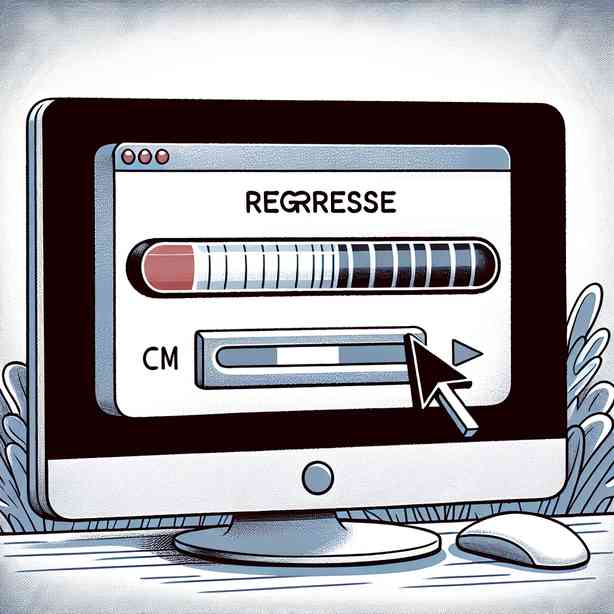
In today’s rapidly evolving digital landscape, the metaphor of a progress bar has taken on a significant meaning. The term “progress bar” not only refers to a visual representation of progress in computing processes but can also be applied to various aspects of life and technology. However, what happens when this progress bar moves backward? This phenomenon can be alarming and disheartening, evoking a sense of frustration and confusion. In this article, we will delve deep into the implications of a backward-moving progress bar in different contexts, exploring its causes, effects, and how one can navigate through these challenging experiences.
First, let us consider the technological realm, where progress bars are most commonly encountered. They are typically utilized in software installations, file downloads, and system updates. A backward movement here could signify several issues, such as a failed installation, connection interruptions, or even system errors. When a progress bar reverses, users may experience anxiety as they witness time and effort seemingly wasted, leading to a breakdown in trust toward the technology at hand. It is essential to recognize that such occurrences are often indicative of underlying problems that require attention.
From a psychological viewpoint, the concept of a backward-moving progress bar can be closely related to setbacks in one’s personal or professional life. Just as users expect a seamless progression when completing a task, individuals strive for continuous improvement and growth. However, life is often unpredictable, and setbacks can manifest unexpectedly, akin to a progress bar retreating. This can occur in various scenarios, such as career advancement, educational pursuits, or personal relationships. Understanding that these setbacks are a normal part of life can help mitigate the anxiety associated with them.
In the realm of career development, for instance, an individual may find themselves faced with challenges such as job loss, demotions, or missed promotions. This can feel like stepping backward after having made significant strides forward. Viewing these situations through the lens of a progress bar can provide clarity. Just as a software update may pause or regress due to unforeseen complications, so too can our careers be subject to external factors beyond our control. Acknowledging the nature of these setbacks allows individuals to regroup and reassess their goals, ultimately leading to greater resilience and adaptability.
Similarly, in educational pursuits, students may experience moments when their progress appears to reverse. This could be due to a poor exam result or difficulty grasping a complex subject. Just as with technology, where an installation might require you to restart or troubleshoot, students can benefit from reevaluating their study strategies, seeking help from peers or instructors, and understanding that setbacks can be a catalyst for growth. The key is to remain focused on long-term goals while adopting a flexible approach to overcoming immediate challenges.
In the context of personal relationships, a backward-moving progress bar might represent conflicts, misunderstandings, or emotional distance that have arisen after a period of intimacy and connection. Just as a progress bar can abruptly drop due to a network issue, so too can relationships experience interruptions. However, such moments can also serve as opportunities for dialogue and healing, allowing individuals to address underlying issues that may have gone unrecognized. By communicating openly and honestly, partners can work through their difficulties and rebuild a stronger bond.
Moreover, in the age of social media and constant connectivity, the metaphor of a progress bar is particularly relevant. People often portray their lives through curated snapshots that suggest a continuous upward trajectory. However, reality is much more complex, with many experiencing periods of regression, whether in terms of mental health, personal achievements, or social connections. Acknowledging that these backward movements exist is crucial for fostering a more authentic and compassionate understanding of each other’s experiences. Just as we would troubleshoot a technological glitch, we must also be willing to explore and address the emotional or psychological triggers that contribute to such regressions.
It is also vital to consider the metrics by which we measure progress. Traditional concepts of success often emphasize tangible achievements, such as wealth or status. However, true progress should encompass personal fulfillment, mental well-being, and healthy relationships—elements that are not always easily quantified. When a progress bar seems to move backward in terms of personal satisfaction or joy, it might indicate a misalignment between one’s values and actions. Taking a step back to reflect on what truly matters can lead to meaningful changes, allowing the progress bar to resume its forward trajectory.
In conclusion, while witnessing a progress bar moving backward can evoke feelings of disappointment or frustration, it is essential to recognize that these experiences are not necessarily indicative of failure. Whether in technology, personal growth, or relationships, setbacks are a natural part of any journey. Embracing these moments as opportunities for learning and reevaluation can help foster resilience and adaptability, allowing individuals to forge ahead with renewed determination. By cultivating a mindset that acknowledges both progress and setbacks, we can navigate life’s challenges more effectively and emerge stronger on the other side. Ultimately, it is not just about the destination but the journey itself, and the lessons learned along the way. Embracing the ups and downs with grace can transform an initially disheartening experience into a valuable opportunity for growth and self-discovery.


